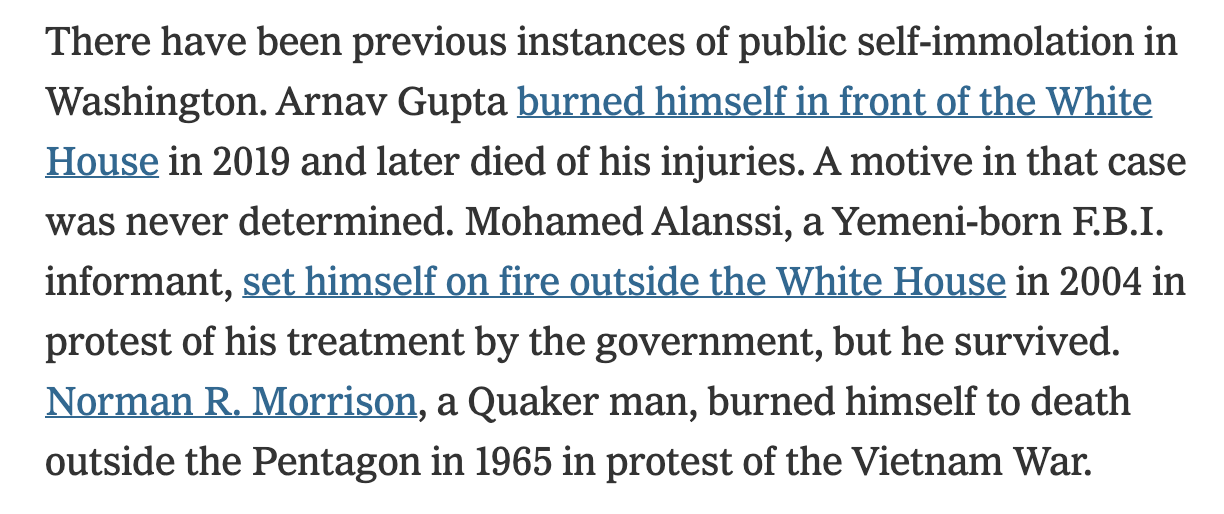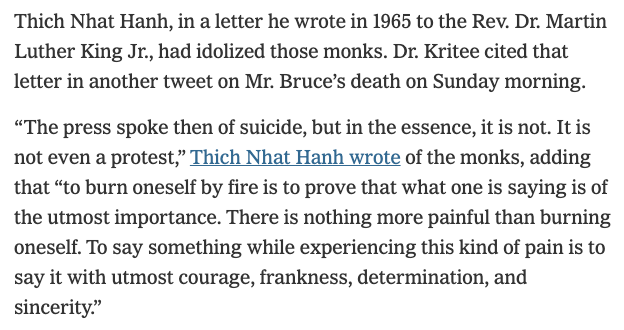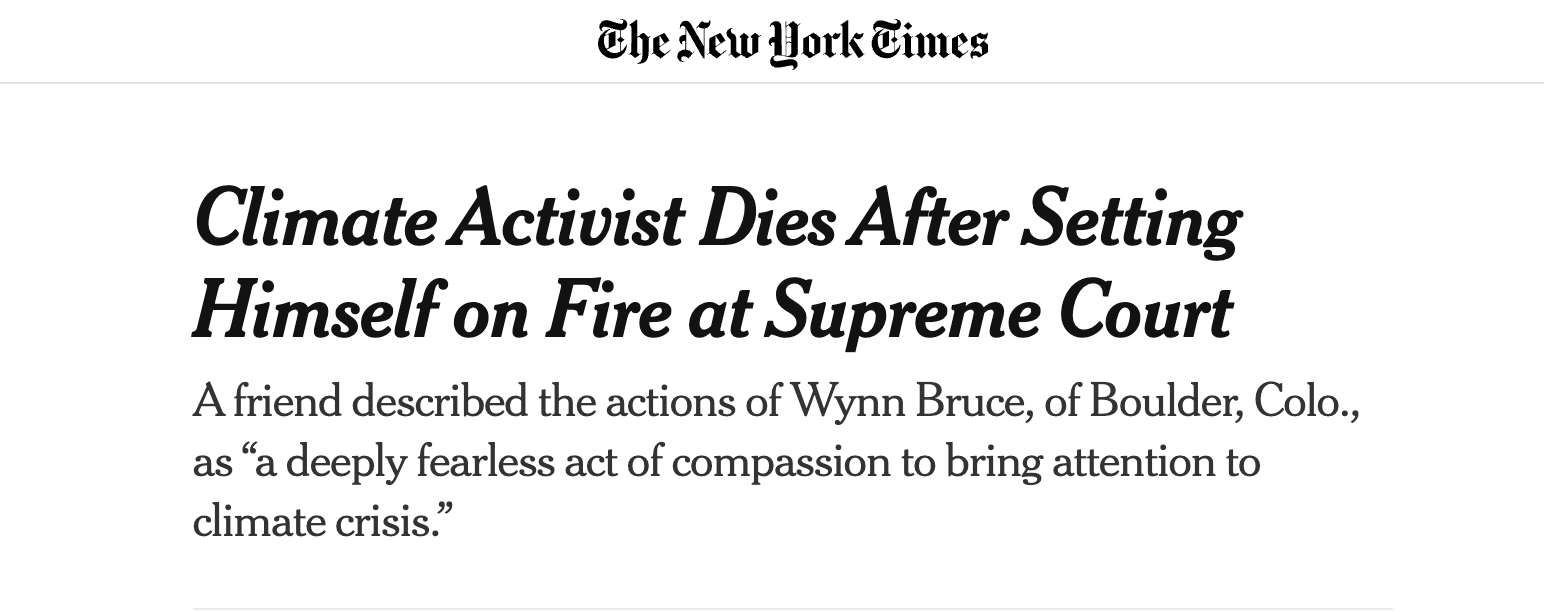Warning: This piece discusses suicide. If you are having thoughts of suicide, call the National Suicide Prevention Lifeline at 1-800-273-8255 (TALK) or go to SpeakingOfSuicide.com/resources for a list of additional resources.
Here’s what you can do when a loved one is severely depressed.
The last thing I want this newsletter to be is another media-criticism center. Given how many already exist, I rarely step into media criticism, though I know it is an important aspect of journalism.
And sometimes, it is unavoidable.
On Tuesday, I read a headline in The New York Times that caught my eye: Climate Activist Dies After Setting Himself on Fire at the Supreme Court. The story had a splashy relevance, an old school "if it bleeds, it leads" kind of heat.
It was also one of the most irresponsible things I've seen published in the paper of record. Not only that, but I've been shocked to find that very few people are discussing how poorly written and dangerous the piece is. Instead, it's mostly been celebrated on social media.
Accompanying the headline about a man lighting himself on fire outside the Supreme Court was this sub-header: A friend described the actions of Wynn Bruce, of Boulder, Colo., as “a deeply fearless act of compassion to bring attention to climate crisis.”
At that, I actually gasped out loud. One of the first things I learned in journalism school was how to cover sensitive issues like suicide and mass shootings in the press. Every newsroom, including the Times’, has standards for this kind of coverage because we know, from an abundance of research, that reporting on suicide and mass shootings in certain ways can actually create a contagion effect. People reading the story favorably are more likely to kill themselves or shoot into a crowded public space.
The crux of The Times story, and its framing, is this: A man lit himself on fire publicly, outside of the Supreme Court. This was not a suicide, but a selfless act of protest. The man was following in the footsteps of a long line of activists who have committed "self-immolation." Many people share his despair about climate change.
The website ReportingOnSuicide.org is an incredible resource for how you should cover suicides, and has helpfully laid out the most basic "dos" and "don'ts" of suicide reporting. Reading them, alongside The Times story, is a rather shocking exercise.
Don't: Describe or depict the method and location of the suicide.
Do: Report the death as a suicide; keep information about the location general.
Not only does the piece never report the death as a suicide, but the only use of the word "suicide" is when The Times quotes Wynn Bruce's friend saying explicitly “This act is not suicide." Also, The Times describes the exact location of where the suicide happened.
Don't: Describe intimate details about the person who died.
Do: Keep information about the person general.
The Times sort of straddles the line here. Obviously, the person in question has been made into a headline, so it's hard not to report on the details of his life. But The Times still does a good job of not describing Bruce's personal appearance, family life, or other factors that may be considered “intimate.” Frankly, this standard may be the hardest to achieve, given that reporting on anyone requires a certain level of inquiry into who they are.
Don't: Present suicide as a common or acceptable response to hardship.
Do: Report that coping skills, support, and treatment work for most people who have thought about suicide.
This is perhaps the most egregious of all the things The Times does in their story. Not only does the paper repeatedly frame his suicide as a response to the climate crisis, but it also contextualizes it with other historical "self-immolations," allowing the reader think it is a common act of protest with historical precedent. And they don’t just discuss previous self-immolations; they also discuss previous self-immolations specific to Washington D.C.

Don't: Oversimplify or speculate on the reason for the suicide.
Do: Describe warning signs and risk factors, including mental illness, that give the suicide context.
Again, The Times egregiously violates this rule throughout the entire piece. The story does not even entertain the idea that Bruce may have had some kind of mental illness in addition to his concerns about climate change. There is no discussion of warning signs, risks, or mental illness anywhere in the piece. In fact, The Times piece does not present a single other possible cause for his suicide except his convictions about climate change inaction. That is the only theory they present, and it relies entirely on a single source and a few social media posts. But even that lone source, Bruce's friend Dr. Kritee Kanko, makes it clear she isn't sure that that’s why he killed himself:

Don't: Sensationalize details in the headline or story.
Do: Report on the death using facts and language that are sensitive to a grieving family.
It's hard not to have a slightly sensational headline when you're reporting on someone who lit himself on fire, but The Times truly does nothing to address this reporting standard. Rather than a headline reading, "Climate Activist Dies After Setting Himself on Fire at Supreme Court," a more appropriate headline may have been something like "Man Dies After Public Self-Immolation in Washington D.C." This would have avoided sensationalizing the headline ("set himself on fire"), avoided ascribing a motive ("climate activist"), and avoided naming the specific location ("Supreme Court").
Don't: Glamorize or romanticize suicide.
Do: Provide context and facts to counter perceptions that the suicide was tied to heroism, honor, or loyalty to an individual or group.
The Times repeatedly quotes Bruce’s friend calling this suicide "fearless" and an "act of compassion." Again, there is only one single mention of the word suicide in the whole piece, and it's when The Times quotes the same friend saying "this act is not suicide," an obvious and outright lie that requires redefining the word suicide (via Merriam-Webster: "the act or an instance of taking one's own life voluntarily and intentionally").
The Times piece goes on to describe Bruce as a self-identified Buddhist who burned himself alive "in an apparent imitation" of the Vietnamese monks who killed themselves in protest of the Vietnam War. Then the Times quotes Thich Nhat Hahn, an influential Zen Buddhist master, and invokes a 1965 letter he sent to Martin Luther King Jr. saying that self-immolation required "utmost courage," "determination" and "sincerity."

All of this is so egregious that I was stunned when I didn't see anyone else talking about it. So I did what a lot of journalists do when they have a problem with a story: I tweeted about it.
The result of that tweet was fascinating, if not a little frightening, too.
Zeeshan Aleem, a columnist at MSNBC, responded to a thread I wrote (making many of the points above) by saying this:
I don't necessarily disagree with everything in this thread but it's far too black-and-white. It is of course possible to describe it as suicide and political protest simultaneously. I'd be curious if Isaac holds the same bar for accounts of political suicide bombings. https://t.co/ei5JDYI5Wo
— Zeeshan Aleem (@ZeeshanAleem) April 26, 2022
And in response to a rather emotional tweet I posted, where I said, “Lighting yourself on fire does not make you a climate activist or a Buddhist or a hero. It means you are sick and need help,” Aleem responded by asking this:
"Does he [Isaac] believe there is no political meaning to, say, an Islamist suicide bomber's actions or a soldier who goes on a mission certain to result in death, and that they are to be described purely as suffering from mental health afflictions?" Aleem then asked.
Aleem was right to call out the binary framing I made. And I should have presented myself more clearly. But the answer is that of course there can be political meaning to an Islamist suicide, and there may have been a political meaning to Bruce's suicide. But these things are categorically different: a suicide bombing kills and injures other people, so it is aptly described as terrorism. The deranged "motive" of an Islamist strapping a bomb to their chest and walking into a cafe is to kill others and move onto to the afterlife in the name of a distorted religious zealotry.
Yes, I do actually think those people should seek help, but it is a different thing entirely. Even so, the word "suicide" is still used to describe it. It's right there in the term Aleem himself used: "suicide bombing."
A better analogy, as I said to Aleem, would be if someone killed themselves with a handgun outside the Supreme Court to protest a restriction of second amendment rights, and then The Wall Street Journal framed the story as a "selfless act of compassion to preserve individual liberty." That is essentially what The Times did, all in the name of “fighting” climate change.
Another Twitter user got upset with me, saying "You're trying to re-classify what he did into a suicide when it was so much more."
At this point, I started to feel like I was in the Twilight Zone. I wasn’t “trying to re-classify” anything — The Times was! Bruce killed himself intentionally. By definition, that is a suicide. I'm not suggesting his suicide couldn't have been, in part, politically motivated, but I am suggesting that publishing an entire piece about it without addressing suicide, offering resources, framing it as a mental health issue, or following the rules about writing on suicides was incredibly irresponsible.
It's also worth asking why this coverage happened.
Take another analogy: If a conservative lit herself on fire on the steps of the Supreme Court to protest abortion, would The Times’ first quote in the piece be a friend calling it "a deeply fearless act of compassion to bring attention to the daily murder of fetuses"? Would even a mainstream right-wing conservative publication do that? Would they go out of the way to avoid calling it suicide, and repeatedly reference the woman's activism and courage instead? Would they cite the Buddhist monks who came before her who killed themselves in similar fashion?
The answer, to me, seems obvious.
The reason The Times reporter (and editors) seemed to feel this was fit for publication is either because they are unaware of the journalistic standards around suicide (highly unlikely) or they sympathized with Bruce (most likely) and felt inclined to frame his act as reasonable, honorable, or otherwise justified. When I wrote about media bias, this is the kind of "insidious" bias I was referring to.
The Washington Post, for their part, handled the story better in some ways, but worse in others. At least they included a link to the suicide hotline at the end of the piece, as well as a description of how Bruce's father had sought out psychiatric counseling for him when he first tried to light himself on fire in 2017 outside the World Trade Center, an apparent recognition by Bruce’s father (and The Washington Post) that this wasn't ordinary activism. Those details, of course, make The Times piece look even worse.
But the Washington Post story also starts with a detailed description of the suicide itself, in which the paper contrasts what you might expect — a screaming, writhing person — with how Bruce actually was: silent, "still, sitting upright on the court’s famous marble plaza." It once again framed him as a climate activist sacrificing himself for the cause (in this story, his father is quoted as "believing" that was his motive, though a real motive remains unclear). To describe the suicide in great detail, and then frame it as a painless act of heroism, is just as egregious as the mistakes The Times made in their piece.
Finally, I want to add one last thing: I know that with all the challenges in the media and the world these days, a story like this may not seem that important. But I also know that two of the most important issues facing our country are climate change and mental health issues. Each deserves much more attention than they're getting, and this story does a disservice to the folks who are interested in addressing either. I am deeply concerned about what our planet will look like 30 years from now, especially for my own kids and grandkids. I'm also saddened by the loneliness, anxiety and depression that dominates the lives of so many Americans today, especially when compared to rates in other countries.
But convincing ourselves that the climate crisis is unsolvable and glorifying suicide as a means of "raising awareness" about the issue is not going to help either cause. I think I could make a pretty good argument that stories like this will actually undermine progress toward solving the climate crisis or addressing our country's mental health issues in a productive way. The next generation is already gripped by climate fatalism, so much so that many young Americans are uninterested in having kids because they are convinced our planet isn't salvageable. Restoring realistic hope, maintaining the will to fight, and embracing the solutions that are already coming to fruition are our ways out. Stories like this create more sadness and nihilism.
Let me be clear: climate change is real, and we need a global effort to combat it. But the worst possible outcome of climate change is still uncertain; and there are dozens of things (carbon capture technology, invest in nuclear energy, consume less, adapt our cities) that we can do to address it. A future where we are fighting wars over water or experiencing food shortages and mass migrations is likely if we take no action. In some places it is already beginning. An uninhabitable planet for humans, however, is definitely not certain. And still, both the bad and the worst futures are avoidable.
More often than not, though, climate coverage is making the mental health crisis worse. Based on everything we know, bringing honor to a "climate protest" suicide is almost certainly going to produce copycats, because already depressed and nihilistic people are going to see this celebration and think that's their best chance of making a difference, when it's not.
That The Times would cover and frame this story this way leaves me thinking that its editors and reporters are also in the fatalist camp. To see this angle in the paper of record, used in the name of glorifying a purportedly noble death, at the risk of spreading the idea of suicide and climate fatalism to more people, is maddening and illuminating all at once.
First time reading Tangle? We're a daily newsletter. Sign up here for more.
Share this post on Twitter by clicking here
On Facebook by clicking here
Via email by clicking here
If you are having thoughts of suicide, call the National Suicide Prevention Lifeline at 1-800-273-8255 (TALK) or go to SpeakingOfSuicide.com/resources for a list of additional resources.
Here’s what you can do when a loved one is severely depressed.
❤️ Enjoy this newsletter?
💵 Drop some love in our tip jar.
📫 Forward this to a friend and let them know where they can subscribe (hint: it's here).
📣 Share Tangle on Twitter here, Facebook here, or LinkedIn here.
🎧 Rather listen? Check out our podcast here.
🛍 Love clothes, stickers and mugs? Go to our merch store!
🙏 Not subscribed? Take the next step and become a subscriber here.



Member comments